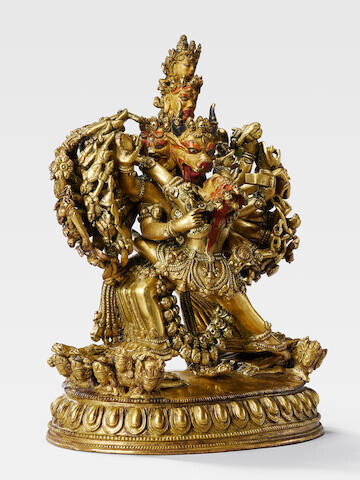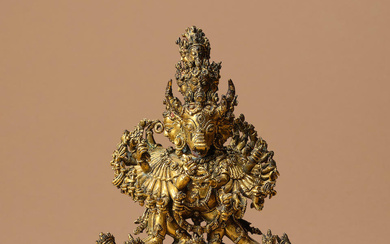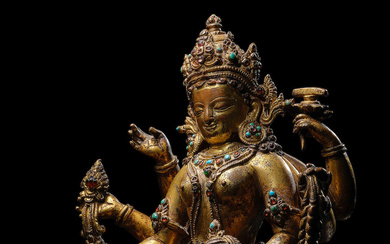A GILT COPPER ALLOY FIGURE OF VAJRABHAIRAVA
TIBET, 18TH CENTURY
TIBET, 18TH CENTURY
With cold gold and polychromy throughout the many faces and hair.
Himalayan Art Resources item no.16808
7 1/2 in. (19 cm) high
西藏 十八世紀 銅鎏金大威德金剛像
This dramatic gilded bronze shows Vajrabhairava lunging in a warrior's pose while in interpenetrative congress with his consort, Vajravetali. Thirty-four of Vajrabhairava's arms encircle him and his partner, brandishing ritual weapons and attributes that symbolize his skillful means. His sixteen legs trample a retinue of prostrate animals and Hindu gods, conveying his supremacy over the physical realms of existence. His central face—that of a ferocious bull—signifies his subjugation of Yama, the Lord of Death, and his triumph over the cycle of birth, death, and rebirth. Vajrabhairava's superposed animal and anthropomorphic heads are well-modeled in this sculpture, with his enthralling primary face commanding the composition's focal point. Vajrabhairava and his consort are clad in matching jeweled aprons and garlands of skulls and freshly severed heads. Vajravetali follows her consort's stance, wrapping her left leg around his waist and grasping onto him with her head thrown back, her fiery hair flowing down to her waist.
Vajrabhairava is a wrathful manifestation of Manjushri, the Great Bodhisattva of Wisdom, who takes this guise as a potent transformative teaching. The worship of Vajrabhairava enjoyed great popularity throughout Tibet, Mongolia, and China during the Qing dynasty. This was in large part due to Vajrabhairava being a primary yidam (transformative deity) of the Gelug monastic order who ascended power in Tibet and were sponsored by the Qing dynasty. The Qianlong Emperor himself (r.1733-1796) was also recognized as an earthly incarnation of Manjushri, Vajrabhairava's spiritual sire.
The present sculpture belongs to a group associated with foremost centers of power within the Qing Empire in the 18th century. Closely related examples, showing similar construction, regalia, and lotus pedestals have been attributed to Tashilunpo Monastery in Tibet (Bonhams, Hong Kong, 29 November 2016, lot 132), and are held within the imperial collections of Rehol Monastery, Chengde and the Qing Palace Collection, Beijing (Hsu, Buddhist Art from Rehol, Taipei, 1999, p.97, no.29, and Wang (ed.), Zangchuan Fojiao Zaoxiang, Hong Kong, 1992, p.92, no.64, respectively).
Provenance
Anthony P. Russo, by inheritance in 1994
Doyle, New York, 16 September 2008, lot 2043
View it on
Sale price
Estimate
Time, Location
Auction House
TIBET, 18TH CENTURY
TIBET, 18TH CENTURY
With cold gold and polychromy throughout the many faces and hair.
Himalayan Art Resources item no.16808
7 1/2 in. (19 cm) high
西藏 十八世紀 銅鎏金大威德金剛像
This dramatic gilded bronze shows Vajrabhairava lunging in a warrior's pose while in interpenetrative congress with his consort, Vajravetali. Thirty-four of Vajrabhairava's arms encircle him and his partner, brandishing ritual weapons and attributes that symbolize his skillful means. His sixteen legs trample a retinue of prostrate animals and Hindu gods, conveying his supremacy over the physical realms of existence. His central face—that of a ferocious bull—signifies his subjugation of Yama, the Lord of Death, and his triumph over the cycle of birth, death, and rebirth. Vajrabhairava's superposed animal and anthropomorphic heads are well-modeled in this sculpture, with his enthralling primary face commanding the composition's focal point. Vajrabhairava and his consort are clad in matching jeweled aprons and garlands of skulls and freshly severed heads. Vajravetali follows her consort's stance, wrapping her left leg around his waist and grasping onto him with her head thrown back, her fiery hair flowing down to her waist.
Vajrabhairava is a wrathful manifestation of Manjushri, the Great Bodhisattva of Wisdom, who takes this guise as a potent transformative teaching. The worship of Vajrabhairava enjoyed great popularity throughout Tibet, Mongolia, and China during the Qing dynasty. This was in large part due to Vajrabhairava being a primary yidam (transformative deity) of the Gelug monastic order who ascended power in Tibet and were sponsored by the Qing dynasty. The Qianlong Emperor himself (r.1733-1796) was also recognized as an earthly incarnation of Manjushri, Vajrabhairava's spiritual sire.
The present sculpture belongs to a group associated with foremost centers of power within the Qing Empire in the 18th century. Closely related examples, showing similar construction, regalia, and lotus pedestals have been attributed to Tashilunpo Monastery in Tibet (Bonhams, Hong Kong, 29 November 2016, lot 132), and are held within the imperial collections of Rehol Monastery, Chengde and the Qing Palace Collection, Beijing (Hsu, Buddhist Art from Rehol, Taipei, 1999, p.97, no.29, and Wang (ed.), Zangchuan Fojiao Zaoxiang, Hong Kong, 1992, p.92, no.64, respectively).
Provenance
Anthony P. Russo, by inheritance in 1994
Doyle, New York, 16 September 2008, lot 2043







